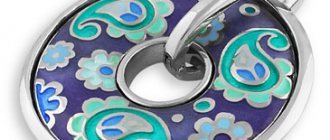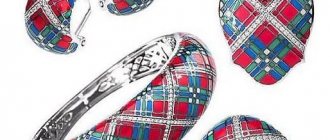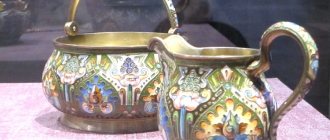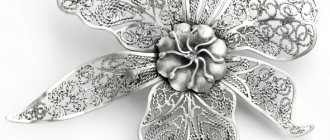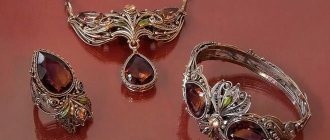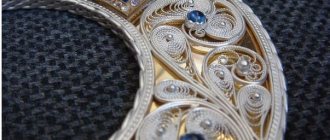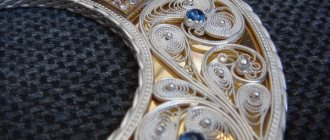Cold enamel
Cold enamel received its purpose due to the peculiarities of the application technique. Before applying to the jewelry, liquid enamel is prepared, which is mixed with catalysts. This produces a special paste, which is applied to the decoration. A thin tool is used for application. After application, the enamel dries for several days.
To increase the strength and durability of the enamel, ultraviolet light can be used to harden it. This allows you to speed up the drying procedure of the enamel. Cold enamel is quite easy to work with. In addition, the finished product rarely chips. Inexpensive jewelry is most often made using the cold enamel method.
UV enamel
The composition of light-curing enamel includes the following components:
- dimethyl acrylates;
- ceramics and other inorganic components;
- initiators for photopolymerization;
- stabilizers to prevent sedimentation;
- pigments to give the required color.
To apply enamel, the surface of the product does not require specific preparation; it can be applied to any metal. The big advantage of this material is that chips or other defects can be restored.
Hot enamel
To obtain a more beautiful decoration, you need to use a complex technique of hot enamel. However, using hot enamel requires special skill and special equipment. To do this, you need to dilute glass powder with water and draw patterns on the decoration like paint. After this, the product must be dried in a special oven so that air bubbles do not appear on the surface of the decoration. Therefore, products are fired at temperatures up to 900 degrees.
Jewelry can be quite complex. In this case, the master may need to apply several dozen layers of enamel, each of which must be fired in a kiln. The temperature at which the enamel is fired is selected based on the personal preferences of the master. That is why each product made using hot enamel has an individual design.
Jewelry enamel technique
Jewelry with enamel is the calling card of SOKOLOV. Thousands of women appreciated the collections Russe, My story, Etude and other jewelry of the brand. We will talk about how jewelry with cold and hot enamel is made and, just as important, how it is preserved in its original form.
Cold enamel
Cold enamels got their name due to the peculiarities of the technological process. Master enamellers are specialists of the highest class. This is one of the creative professions in jewelry production. It is also one of the most difficult - a craftsman can work on some jewelry all day long. Professionalism is especially important when making earrings. Both pieces included in the kit must look the same, which is especially difficult given the manual production.
Liquid two-component enamel is mixed in certain proportions with a catalyst, forming a creamy paste. Then, using a special tool, the enamel is applied to the metal surface. In some cases, the enamel is laid using a custom-designed tool with improved ergonomics, which allows you to paint over products in hard-to-reach places.
The cold enamel technique is different in that after application the enamel hardens at room temperature for 72 hours, and at a temperature of 60 degrees for 3 hours, and looks like a ceramic coating. In this case, the colorist can mix enamels to obtain different colors and shades according to the Pantone system. The enamel laid in this way is also called heat-curing.
A special type of enamel is light-curing. This is the name for a coating that hardens under the influence of special lighting.
The advantages of so-called cold enamels include the simplicity and manufacturability of their use. Coating application requires virtually no equipment, as well as specific preparation of the surface of the product. Enamels are perfectly applied to any alloys; they are flexible and quite unpretentious in use.
Hot enamel
The technology for applying hot enamel is more complex.
Initially, enamel is glassy plates. The artist crushes them and grinds them in a ceramic mortar to obtain the finest powder. The enamel powder is moistened with water to the desired consistency and mixed into a creamy paste.
Only after this can the coating be applied to the metal surface with a special tool. The hot enamel is then sent into the kiln and fired. Different types and colors of enamel have different firing temperatures, which range from 700 to 900 degrees. During firing, the powder fuses into a colored glassy layer and, depending on the type of enamel, becomes transparent or the so-called dull - that is, a colored opaque layer of enamel. Once cured, the product is sanded and returned to the oven to ensure a perfectly smooth surface.
Based on the characteristics of the composition of the product and the tasks facing the craftsman, the work can be fired from 5 to 100 times. The difficulty is that the master does not have the opportunity to intervene in the process, but can only, based on experience and intuition, regulate the firing time and temperature. This is what creates the uniqueness of each work with enamel - even the author cannot repeat it. Each work exists in only one copy, it is unique.
How to care for enamel jewelry?
Jewelry with enamel coating differs from other products not only in its original design, but also in its specific care. To maintain the original brightness of enamel paints, you must follow a few simple rules.
Rule 1. The decorative coating is a thin layer of glass, so it is sensitive to mechanical stress. An impact can cause chips and cracks in the enamel, so it is not recommended to drop products with enamel.
Rule 2. Jewelry with enamel must be protected from exposure to direct sunlight, as well as temperature changes. They are not recommended to be worn in a solarium, on the beach, in a bathhouse or sauna. Otherwise, the coating may fade or crack.
Rule 3. Do not allow enamel to come into contact with acids, alkalis and chlorine, that is, with any detergents, powders and cleaning gels. Also, the coating can be damaged by interaction with cosmetics (creams, lotions, shampoos, etc.) and sea water.
Rule 4. In order to maintain the brightness of the jewelry, but not damage the enamel coating, products with enamel must be washed in cool water, adding a small amount of ammonia. To clean the enamel, you can use a soft brush and tooth powder. Then the jewelry must be rinsed in clean water and wiped with a soft cloth. However, the best care for enamel jewelry can only be performed by a specialist in a jewelry workshop.
Rule 5. Products with enamel are recommended to be stored separately so that their surface does not come into contact with other metals.
Methods of applying enamel to jewelry
There are several basic techniques for applying enamel to jewelry. The most popular include:
- Cloisonne enamel. In this case, it is necessary to draw the outline of the future image on metal plastic. It is along this contour that thin metal strips will be soldered. The resulting cells are filled with powder, from which the enamel will be made. At this stage, the product is fired in a kiln, so the enamel melts, filling the metal partitions. After that, you just need to sand and polish the product.
- Stained glass enamel. The features of the technology are similar to the previous one. Stained glass enamel is also created by filling the openwork frame with enamel powder. However, in this case, a metal plate is not used as a base. In this case, colored translucent enamel is used, which, after firing, plays in the sun, reminiscent of stained glass. But creating stained glass enamel is difficult work. And a small mistake can lead to the need to start the work all over again.
- Picturesque enamel. This type of enamel involves the need to paint a real picture on a piece of jewelry. The metal base will act as a canvas, and the enamel will act as oil. After firing, the painted enamel acquires depth.
Enamels are also divided according to their appearance. According to this parameter, they can be divided into transparent, transparent colored, opal and opaque.
Where to buy jewelry creations with hot or cold enamel
Professional jewelers apply “paint” to the surface of precious metals. Accordingly, such products are sold in jewelry stores and workshops. You should not pay attention to offers “from unknown sources.” Jewelry, like classic versions with stones, must have jewelry tags. They will not indicate the composition of the enamel, but there will certainly be information about the type of alloy and the weight of the jewelry.
Follow the advice on choosing and caring for jewelry with enamel, then it will last you a long time. Remember that all such jewelry is made by hand, so their cost is not so low.
How to independently distinguish a product with cold and hot enamel
To understand what enamel is used to coat jewelry, you need to perform simple manipulations. First, you need to press some sharp object onto the enamel in an inconspicuous place. If it is done cold, it will leave a mark. In addition, cold enamel is warm to the touch, while hot enamel is, on the contrary, cold. This is due to the fact that cold enamel is a layer of special paint, and hot enamel is glass, which at high temperatures turns almost into stone. The product, made on the basis of cold enamel, is not polished, so it has small irregularities.
Order a service
How to care for the finished product at home
Do you want your hot or cold enamel jewelry to retain its beauty for as long as possible? Follow simple rules for caring for such exclusive jewelry:
- The decorative layer is comparable to glass, so it does not withstand strong mechanical stress. Be careful not to hit or drop jewelry.
- Direct strong sunlight may heat the product and cause colors to lose vibrancy. Do not leave rings and earrings in the open sun. It is best to store them in a box.
- Acids, alkalis and bleach destroy the enamel surface. There is no need to wash the dishes and the floor when you are wearing rings with jewelry enamel on your hands.
- Rinse items under cold running water. You can drop a small amount of ammonia to remove dirt from the surface. And also use a toothbrush with soft bristles.
- It is advisable to store enamel jewelry separately from other jewelry. When in contact with certain metals, the color and brightness of the coating change.
And remember, the better you feel about jewelry, the longer it will delight you with its beauty and brilliance. Allow yourself neat luxury.
Cloisonne enamel
Jewelry with cloisonne enamel is one of the most elegant techniques. A design is laid out on a plate of precious metal using thin silver wires. Glaze is applied inside these partitions.
In ancient times, this technique was used to shade the entire beauty of gemstones in a piece. The jewelry of Ancient India that has survived to this day demonstrates all the diversity of colors of pure gems. Also, the product could be provided with chasing, and all this was called “minankari”.
In the Chinese tradition, on the contrary, it was not customary to combine glaze and jewelry stones. It was a very delicate work, akin to modern printing. Cloisonne enamel was mainly used on valuable household items. Vessels and vases were decorated with traditional images of real and mythical animals. In Europe and Russia, a similar technique is called stained glass enamel.
True cloisonné technique is an example of delicate and labor-intensive work. This is a one-of-a-kind item, unique in its kind.
There is no mass production here. With its help, exclusive jewelry is prepared for a specific customer.
Signs of septal enamel:
- fine work drawing;
- the contours are formed by a thin wire, which can be seen in its entirety, even in the photo;
- the price of the product is quite high.
Jewelry using this technique is rarely found in large production facilities, nor are they found in large jewelry stores that work with major brands. Similar products can be found in small jewelry workshops, on Internet resource sites dedicated to handmade topics, and at exhibitions.
In such places you can actually get original jewelry with history.
Technology of products with cloisonne enamel
If you look at the drops collected in the web after rain, you can understand the principle of cloisonne enamel. First, a contour is laid out with wire, which is then filled with a multi-colored mass. The product dries and is fired. One gets the impression that glass is framed in metal lace.
Enameling technology is quite labor-intensive:
- a sketch is applied to a metal base with white gouache;
- the workpiece is cut or minted according to the design;
- the base for the product is bleached in acid before being covered with a layer of enamel, then fired in an oven at a temperature of 800C;
for partitions, 999-grade wire is used: here you work with tweezers and pliers. Frame elements are formed, which are fastened with a special glue that burns out when fired;- The glaze is diluted with water and poured into the cells. First, the product needs to dry so that the water does not disturb the structure of the design;
- the decoration is placed in a preheated muffle furnace;
- The product cannot be exposed to sudden temperature changes, so it must cool naturally.
Firing can occur many times to achieve the desired color and shade. The cloisonne technique differs from stained glass in that it has a base. Stained glass enamel is transparent to light, like glass.
